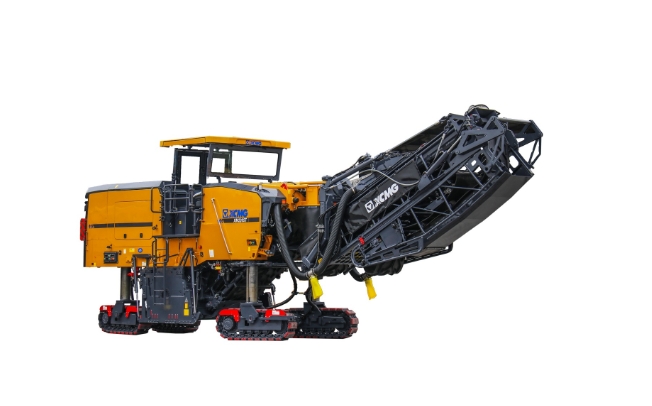Road milling machines are mainly used for excavation and renovation of asphalt concrete surface layers in highways, urban roads, airports, cargo yards, parking lots, etc., removal of bumps, oil waves, reticulation, rutting, etc. on asphalt roads, roughening of cement roads and milling of surface misalignment. When purchasing a milling machine, whether to choose a new machine or a second-hand equipment requires comprehensive consideration of budget, project requirements, maintenance costs, technological advancement and other factors.
The following are specific analysis and precautions:
1. Comparison of the advantages and disadvantages of new and second-hand equipment
Comparaison des avantages et des inconvénients des équipements neufs et d’occasion
(1). Advantages of new machine/Avantages de la nouvelle machine
• Advanced technology: New models are usually equipped with the latest technology, such as exhaust treatment systems (DOC+DPF+SCR) that meet the National IV emission standards, automatic leveling systems, energy-saving designs, etc., and are suitable for areas with high environmental protection requirements.
• Stable performance: The core components of the new machine (such as the engine and milling rotor) have less wear and tear and a low failure rate, making it suitable for high-intensity, long-cycle projects.
• Complete after-sales service: The manufacturer provides warranty, parts support and operation training to reduce the risk of subsequent maintenance.
(2). Advantages of second-hand equipment/Avantages du matériel d’occasion
• Low cost: The price is usually 30%-50% of a new machine, suitable for projects with limited budgets or short-term projects.
• High flexibility: can be put into use quickly, suitable for temporary and small-scale engineering needs.
(3). Disadvantages comparison/Comparaison des inconvénients
• High cost of new machines: The initial investment is large and may exceed the budget of SMEs.
• Risks of second-hand equipment: There are problems such as aging of core components (such as engines and hydraulic systems) and lagging emission standards (such as National III models may be restricted).
2. Things to note when buying a new machine
Choses à noter lors de l’achat d’une nouvelle machine
(1). Clarify emission standards/Clarifier les normes d’émission
o Some regions in China have implemented the National IV emission standards, so you need to choose a model that complies with local regulations (such as Cat® PM620 National IV version, etc.).
o Some new models use intelligent fuel-saving technologies (such as automatic throttle control) to reduce long-term operating costs.
(2). Match working conditions/Adapter les conditions de travail
o Milling scale: The milling scale of a single project: only local repair, small scale, medium scale or large scale, or even super large scale, is usually judged by the approximate requirements of the total amount of milling and the milling period. Large-scale projects require large machines; small-scale repairs can choose medium or small machines.
o Functional configuration: complex working conditions require attention to the automatic leveling system, conveyor belt swing capability, dust removal system (such as VCS vacuum dust removal), etc.
(3). Test and acceptance/Test et acceptation
o Require the manufacturer to conduct on-site machine trials to test milling efficiency, control stability and core functions (such as automatic leveling accuracy and feed speed).
3. Things to note when purchasing second-hand equipment
Points à prendre en compte lors de l’achat d’équipement d’occasion
(1). Check the device history/Vérifiez l’historique de l’appareil
o Check the age, maintenance records, and original factory maintenance, and give priority to equipment with complete maintenance records.
o Focus on testing the wear degree of core components such as the engine, hydraulic system, and milling rotor.
(2). Emission standards and regulations/Normes et réglementations en matière d’émissions
o Confirm whether second-hand equipment meets current environmental protection requirements (such as National IV Standard) to avoid being restricted from use due to substandard emissions1.
(3). Evaluate the cost-effectiveness/Évaluer le rapport coût-efficacité
o Compare the price of a new machine with the cost of repairing a used machine (e.g. tool replacement, engine overhaul) to avoid high hidden expenses.
(4). After-sales service support/Service après-vente
o Confirm whether there is original manufacturer or third-party repair service to ensure the supply of spare parts (such as milling rotor, sensor).
4. General Recommendations/Recommandations générales
(1). Clarify demand priorities/Clarifier les priorités de la demande
o For long-term projects or high-precision requirements: new machines are preferred; for short-term or low-frequency use: second-hand machines are considered.
(2). Focus on technological innovation/Mettre l’accent sur l’innovation technologique
o The new machine’s energy-saving design (such as a low-speed, high-torque engine) and intelligent functions (such as automatic leveling) can significantly improve efficiency.
(3). Contract and Guarantee/Contrat et garantie
o Sign a detailed contract to clarify the equipment status, warranty terms and after-sales service content to avoid disputes.
Summarize
New machines are suitable for users who have high requirements for performance, environmental protection, and stability, while second-hand equipment is more suitable for scenarios with limited budgets and the ability to bear certain risks. No matter which one you choose, you need to make a comprehensive assessment based on specific working conditions, maintenance capabilities, and long-term costs. It is recommended to obtain equipment through agents or manufacturers first, and make full use of the trial run to verify performance.
Les machines neuves conviennent aux utilisateurs qui ont des exigences élevées en matière de performances, de protection de l’environnement et de stabilité, tandis que les équipements d’occasion sont plus adaptés aux scénarios avec des budgets limités et la capacité de supporter certains risques. Quelle que soit la méthode choisie, une évaluation complète doit être réalisée en fonction des conditions de travail spécifiques, des capacités de maintenance et des coûts à long terme. Il est recommandé de se procurer d’abord l’équipement auprès d’agents ou de fabricants et de profiter pleinement de la période d’essai pour vérifier les performances.
How to buy Milling Machine/fraiseuse/Fresadora maintenance related accessories at CCMIE?
If you need to buy Milling Machine/fraiseuse/Fresadora or a new Milling Machine/fraiseuse/Fresadora , you can contact us. If you need to buy a second-handMilling Machine/fraiseuse/Fresadora , you can also contact us. CCMIE provides you with comprehensive Milling Machine/fraiseuse/Fresadora.
Post time: Apr-24-2025

